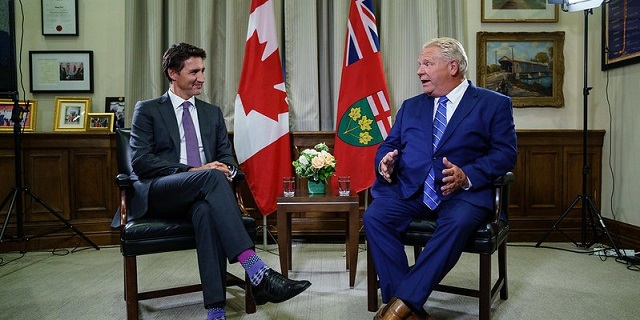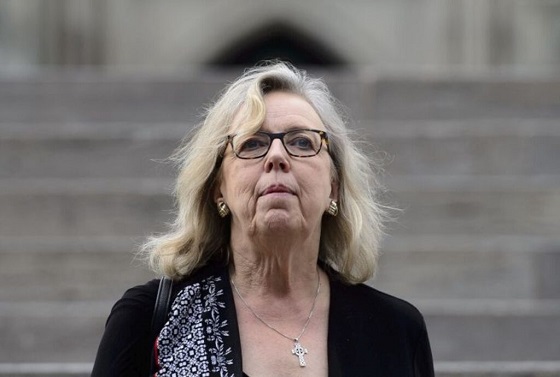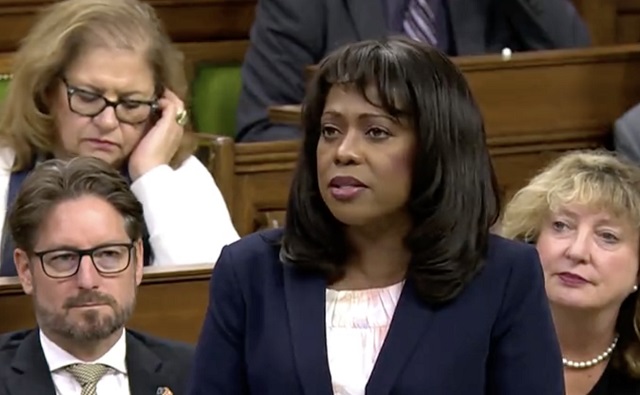Economy
The Good, the Bad and the Ugly—government budgets in 2024

From the Fraser Institute
By Grady Munro and Jake Fuss
Research showed the federal government could balance its budget in two years by slowing spending growth, yet instead the government doubled down and increased spending well past its previous estimates (against the wishes of Canadians)
This fiscal year, most provinces (and the federal government) demonstrated irresponsible fiscal management, although some were better than others. Therefore, in the words of the 1966 film starring Clint Eastwood, let’s discuss The Good, the Bad and the Ugly of Canadian government budgets in 2024.
Falling in the “good” category are Alberta and New Brunswick—the only two provinces planning to run a balanced budget in 2024/25, with Alberta forecasting a $367 million surplus and New Brunswick forecasting a $41 million surplus. Both provinces forecast surpluses until at least 2026/27, and expect net debt (total debt minus financial assets) as a share of the economy to decline in the years to come. However, what keeps these provinces from having a great budget is that both chose to further increase spending in the face of higher revenues, while failing to deliver much-needed tax relief.
Alberta in particular remains at risk of seeing future surpluses disappear, as the province relies on historically high resource revenues to fund its high spending. Should these volatile revenues decline, the province would return to operating at a deficit and growing its debt burden.
Provinces in the “bad” category include, but aren’t limited to, Saskatchewan and Newfoundland and Labrador. Largely due to quick growth in program spending that wipes out any revenue gains, both provinces expect deficits in 2023/24 and 2024/25 before planning to balance their budgets in 2025/26. The risks of unchecked spending growth are most salient in Saskatchewan, where just one year ago the province projected surpluses in both 2023/24 and 2024/25. And resulting from many years of deficits and debt accumulation, debt interest costs in Newfoundland and Labrador are expected to reach $2,123 per person in 2024/25, the highest in Canada.
Key governments among the “ugly” are the federal government, Ontario and British Columbia. Let’s take them one by one.
The federal government delivered a budget that continues the same failed approach that’s produced nearly a decade of stagnation in Canadian living standards. The Trudeau government plans to run a $39.8 billion deficit in 2024/25, followed by deficits of $20.0 billion or higher until at least 2028/29. Prior to the budget, research showed the federal government could balance its budget in two years by slowing spending growth, yet instead the government doubled down and increased spending well past its previous estimates (against the wishes of Canadians).
In addition to continuous spending increases and debt accumulation, the Trudeau government increased capital gains taxes on all businesses and many Canadians. Presented as a way to make the tax system more “fair” while generating $20 billion in revenue, in reality it is a harmful tax increase that is unlikely to generate the planned amount of revenues while simultaneously hindering economic growth and prosperity.
Similar to the federal government, in its 2024 budget Ontario’s Ford government simply doubled down on the same approach it’s taken in previous years. This “stay the course” fiscal plan added an average of $3.8 billion in new annual program spending (compared to last year’s budget) over the three years from 2023/24 to 2025/26. This new spending delays the province’s expected return to surpluses until 2026/27, and rather than run a $200 million surplus in 2024/25 the Ford government now plans to run a $9.8 billion deficit.
Importantly, the Ford government failed to deliver any meaningful tax relief for Ontarians in this budget, which once again breaks its promise to reduce personal income tax rates. Given that Ontarians face some of the highest personal income tax rates in North America, relief would help keep money in people’s pockets while also promoting economic growth.
Finally, the Eby government in B.C. tabled a budget that can be best described as a generational error in terms of the planned debt accumulation. The government plans to run a $7.9 billion deficit in 2024/25, followed by deficits of $7.8 billion and $6.4 billion in 2025/26 and 2026/27, respectively. In other words, the Eby government plans to run deficits in the coming years that are nearly as large or larger than those expected in Ontario, despite B.C. having a little over one-third of Ontario’s population.
Runaway spending drives these deficits and will contribute to a $55.1 billion (74.7 per cent) increase in provincial net debt from 2023/24 to 2026/27. This massive runup in debt will result in higher debt interest costs, which leaves less money available for services such as healthcare and education, or pro-growth tax relief for British Columbians.
By and large, governments across Canada demonstrated an irresponsible approach to managing public finances in this year’s round of budgets. While there were a couple of bright spots, the majority of provinces instead chose to increase spending, grow deficits and debt, and introduce little to no meaningful tax relief.
Authors:
Economy
What the Data Shows About the New Canada-Alberta Pipeline Opportunity

From Energy Now
By Canada Powered by Women
Canada has entered a new period of energy cooperation, marking one of the biggest shifts in federal–provincial alignment on energy priorities in years.
Last week as Prime Minister Mark Carney and Alberta Premier Danielle Smith signed a memorandum of understanding (MOU) that outlines how both governments will approach a potential pipeline to British Columbia’s coast.
The agreement, which has been described as a “new starting point” after years of tension, lays the groundwork for a privately financed pipeline while also linking this commitment to a broader set of infrastructure priorities across oil and gas, LNG, renewables, critical minerals and electricity transmission.
It also sets out how a privately financed project, moving roughly 300,000 to 400,000 barrels of oil to global markets each day, will be reviewed.
Now that the announcement is behind us, attention has turned to how (or if) a pipeline is going to get built.
Alberta has set out its ambitions, British Columbia has its conditions, and the federal government has its own expectations. Together, these positions are shaping what some are calling a “grand bargain” which will be made up of trade-offs.
Trade-offs are not a new concept for the engaged women that Canada Powered by Women (CPW) represents, as they’ve been showing up in our research for several years now. And anyone who reads us also knows we like to look at what the data says.
According to new polling from the Angus Reid Institute, a clear majority of Canadians support a pipeline, with national backing above 60 per cent. And there’s strong support for the pipeline among those in B.C. This aligns with other emerging data points that show Canadians are looking for practical solutions that strengthen affordability and long-term reliability.
By the numbers:
• 60 per cent of Canadians support the pipeline concept, while 25 per cent oppose it.
• 53 per cent of people support in British Columbia, compared to 37 percent opposed.
• 74 per cent of people in Alberta and Saskatchewan support the pipeline.

Our research shows the same trends.
A large majority (85 per cent) of engaged women agree that building pipelines and refining capacity within the country should be prioritized. They favour policies that will progress stability, affordability and long-term economic opportunity.
A key feature of the MOU is the expectation of Indigenous ownership and benefit sharing, which Alberta and B.C. governments identify as essential, and which aligns with public opinion. As of right now, Indigenous groups remain split on support for a pipeline.
The agreement also signals that changes to the federal Oil Tanker Moratorium Act may need to be considered. The moratorium, in place since 2019, is designed to limit large tanker traffic on the North Coast of B.C. because of navigation risks in narrow channels and the need to protect sensitive coastal ecosystems.
Those in favour of the pipeline point to this as a critical barrier to moving Canadian oil to international markets.
Polling from the Angus Reid Institute shows that 47 per cent of Canadians believe the moratorium could be modified or repealed if stronger safety measures are in place. Again, we come back to trade-offs.
The MOU is a starting point and does not replace consultation, environmental review or provincial alignment. These steps are still required before any project can advance. Taken together, the agreement and the data show broad support for strengthening Canada’s energy options.
This will be an issue that engaged women are no doubt going to watch, and the conversation is likely to move from ideas to discussing what trade-offs can be made to bring this opportunity to life.
Business
US Energy Secretary says price of energy determined by politicians and policies


From the Daily Caller News Foundation
During the latest marathon cabinet meeting on Dec. 2, Energy Secretary Chris Wright made news when he told President Donald Trump that “The biggest determinant of the price of energy is politicians, political leaders, and polices — that’s what drives energy prices.”
He’s right about that, and it is why the back-and-forth struggle over federal energy and climate policy plays such a key role in America’s economy and society. Just 10 months into this second Trump presidency, the administration’s policies are already having a profound impact, both at home and abroad.
While the rapid expansion of AI datacenters over the past year is currently being blamed by many for driving up electric costs, power bills were skyrocketing long before that big tech boom began, driven in large part by the policies of the Obama and Biden administration designed to regulate and subsidize an energy transition into reality. As I’ve pointed out here in the past, driving up the costs of all forms of energy to encourage conservation is a central objective of the climate alarm-driven transition, and that part of the green agenda has been highly effective.
Dear Readers:
As a nonprofit, we are dependent on the generosity of our readers.
Please consider making a small donation of any amount here.
Thank you!
President Trump, Wright, and other key appointees like Interior Secretary Doug Burgum and EPA Administrator Lee Zeldin have moved aggressively throughout 2025 to repeal much of that onerous regulatory agenda. The GOP congressional majorities succeeded in phasing out Biden’s costly green energy subsidies as part of the One Big Beautiful Bill Act, which Trump signed into law on July 4. As the federal regulatory structure eases and subsidy costs diminish, it is reasonable to expect a gradual easing of electricity and other energy prices.
This year’s fading out of public fear over climate change and its attendant fright narrative spells bad news for the climate alarm movement. The resulting cracks in the green facade have manifested rapidly in recent weeks.
Climate-focused conflict groups that rely on public fears to drive donations have fallen on hard times. According to a report in the New York Times, the Sierra Club has lost 60 percent of the membership it reported in 2019 and the group’s management team has fallen into infighting over elements of the group’s agenda. Greenpeace is struggling just to stay afloat after losing a huge court judgment for defaming pipeline company Energy Transfer during its efforts to stop the building of the Dakota Access Pipeline.
350.org, an advocacy group founded by Bill McKibben, shut down its U.S. operations in November amid funding woes that had forced planned 25 percent budget cuts for 2025 and 2026. Employees at EDF voted to form their own union after the group went through several rounds of budget cuts and layoffs in recent months.
The fading of climate fears in turn caused the ESG management and investing fad to also fall out of favor, leading to a flood of companies backtracking on green investments and climate commitments. The Net Zero Banking Alliance disbanded after most of America’s big banks – Goldman Sachs, J.P. Morgan Chase, Citigroup, Wells Fargo and others – chose to drop out of its membership.
The EV industry is also struggling. As the Trump White House moves to repeal Biden-era auto mileage requirements, Ford Motor Company is preparing to shut down production of its vaunted F-150 Lightning electric pickup, and Stellantis cancelled plans to roll out a full-size EV truck of its own. Overall EV sales in the U.S. collapsed in October and November following the repeal of the $7,500 per car IRA subsidy effective Sept 30.
The administration’s policy actions have already ended any new leasing for costly and unneeded offshore wind projects in federal waters and have forced the suspension or abandonment of several projects that were already moving ahead. Capital has continued to flow into the solar industry, but even that industry’s ability to expand seems likely to fade once the federal subsidies are fully repealed at the end of 2027.
Truly, public policy matters where energy is concerned. It drives corporate strategies, capital investments, resource development and movement, and ultimately influences the cost of energy in all its forms and products. The speed at which Trump and his key appointees have driven this principle home since Jan. 20 has been truly stunning.
David Blackmon is an energy writer and consultant based in Texas. He spent 40 years in the oil and gas business, where he specialized in public policy and communications.
-

 Energy16 hours ago
Energy16 hours agoA look inside the ‘floatel’ housing B.C.’s LNG workforce
-

 International1 day ago
International1 day agoFBI may have finally nabbed the Jan. 6 pipe bomber
-

 COVID-1924 hours ago
COVID-1924 hours agoUniversity of Colorado will pay $10 million to staff, students for trying to force them to take COVID shots
-

 Business2 days ago
Business2 days agoCanada’s climate agenda hit business hard but barely cut emissions
-

 espionage1 day ago
espionage1 day agoDigital messages reportedly allege Chinese police targeted dissident who died suspiciously near Vancouver
-

 Energy16 hours ago
Energy16 hours agoELZABETH MAY HAS IT WRONG: An Alberta to Prince Rupert Oil Pipeline Will Contribute to Greater Global Oil Tanker Safety
-

 Alberta2 days ago
Alberta2 days agoAlberta Sports Hall of Fame Announces Class of 2026 Inductees
-

 Censorship Industrial Complex2 days ago
Censorship Industrial Complex2 days agoConservative MP Leslyn Lewis slams Liberal plan targeting religious exemption in hate speech bil


